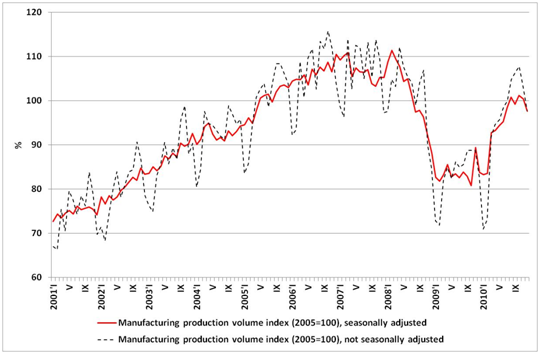Industrial output uneven, growth expected to moderate
In the last months of 2010 an unsteady growth tendency was observed in manufacturing and annual growth rate gradually diminished – a development that was expected: as manufacturing output grew for a long time, some industrialists and particularly the export-oriented manufacturers have reached their maximum capacity.
Month-on-month, the manufacturing output in December dropped by 2.8% (seasonally adjusted data of the Central Statistical Agency). Year-on-year, output grew 16.3% (data adjusted to the number of working days).
Overall, the output in the manufacturing industries grew 14.0%, mining industry 9.7% and electrical power and gas supply 13.7% in 2010 (data adjusted to the number of working days) compared to 2009.
If we are to evaluate the subsector indicators, the greatest increase, 27.2%, in output volumes in 2010 was observed in wood pulp processing and wood products; 25.1% in ready-made metal products, 19.3% in textile products, 36.3% in electrical appliances, 18.1% in chemicals and chemical products. A drop in output volumes was observed in food production – 0.3%, pharmaceuticals – 2.5%, and furniture – 1.5%.
Evaluating the prospects, it becomes obvious that to increase output volumes without additional investments is virtually impossible, yet the current statistics on investment does not indicate industrialist readiness to increase production capacities and output, the possible reason being uncertainty regarding the future economic situation both on the domestic and international scale. With increasing frequency industrialists mention the lack of labour alongside that of equipment as a factor limiting growth (European Commission survey results on the first quarter of 2011.
In the labour market, a surplus of less qualified labour force is likely to remain in 2011 while there will be a deficit of highly qualified and specialized employees (according to sector association and enterprise information, this may particularly be the case in metal manufacturing and the production of electrical appliances). In addition, banks are still relatively conservative in the lending market, which prevents most enterprises with a potential for expansion from doing so. In 2011 the manufacturing industry is expected to continue to increase its output volumes, but the growth rate will be lower because of a higher base for comparison. A gradual strengthening of the domestic demand alongside price levels in the global raw material markets and economic growth of Latvia's main trading partners may promote an increase in the manufacturing industry output (most EU member states are consolidating their budgets this year and that may have a detrimental effect on their demand).
The recovery of the Latvian manufacturing last year was mostly based on foreign markets and the increase in price competitiveness. To continue to increase output volumes, the manufacturing industry needs investment not only in developing new production lines, development of products but, equally importantly, in education: in training and retraining of employees and the unemployed. The moment is ripe not only for restoring the numerical balance between supply and demand but also for addressing quality issues making use of the turning of the attention of the economic policy makers to the necessary reforms in education.

Textual error
«… …»






